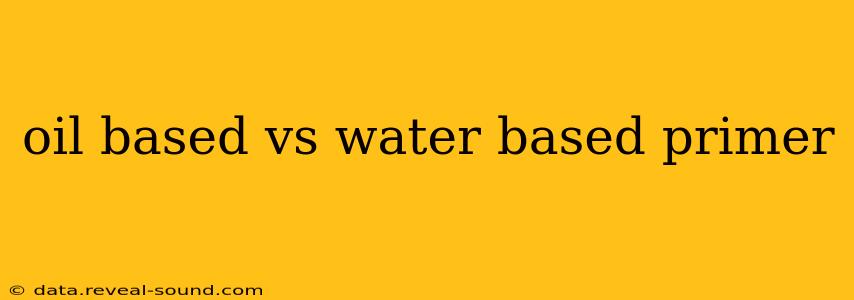Choosing the right primer can significantly impact the final look and longevity of your paint job. The decision often comes down to oil-based versus water-based options. Both have their advantages and disadvantages, making the selection crucial for achieving a professional finish. This guide will delve into the key differences, helping you determine which type best suits your needs.
What are the Key Differences Between Oil-Based and Water-Based Primers?
The fundamental distinction lies in their composition: oil-based primers utilize solvents like mineral spirits, while water-based primers, as the name suggests, use water as their base. This seemingly small difference leads to a cascade of variations in their properties, application, and suitability for different projects.
Drying Time:
-
Oil-based primers: Dry much slower than water-based primers, often taking several hours or even overnight to fully cure. This extended drying time offers a longer working window for blending and correcting mistakes, but it also means a longer project timeframe.
-
Water-based primers: Dry significantly faster, usually within a few hours, allowing for quicker project completion. However, this rapid drying time means less time for corrections.
Clean-Up:
-
Oil-based primers: Require mineral spirits or other solvents for cleanup, which are more hazardous and require careful disposal.
-
Water-based primers: Are easily cleaned up with soap and water, making them a more environmentally friendly and convenient option.
Durability and Adhesion:
-
Oil-based primers: Generally offer superior adhesion to various surfaces, including glossy or previously painted areas. They create a harder, more durable finish, making them ideal for high-traffic areas or exterior projects. They also offer excellent stain blocking capabilities.
-
Water-based primers: While offering good adhesion, they may not be as effective on glossy surfaces or those with significant imperfections. Modern water-based primers are constantly improving in this area, however.
VOCs (Volatile Organic Compounds):
-
Oil-based primers: Contain higher levels of VOCs, contributing to air pollution and potentially causing health issues. Regulations regarding VOCs are becoming increasingly stringent.
-
Water-based primers: Have significantly lower VOCs, making them a more environmentally friendly choice.
Cost:
- Both oil-based and water-based primers are available at a range of price points, so cost is not always a deciding factor.
What Type of Surface are you Priming?
The type of surface you're preparing heavily influences the primer choice.
Is it Glossy?
Oil-based primers excel on glossy surfaces because they cut through the existing shine, providing a better surface for the topcoat to adhere to. Water-based primers may require extra sanding to ensure proper adhesion on glossy surfaces.
Is it Porous?
Water-based primers are often better suited for porous surfaces like drywall or plaster because they can penetrate more deeply, filling in small imperfections and providing a smoother base for painting.
Is it Metal?
Oil-based primers are often preferred for metal surfaces due to their superior rust-inhibiting properties. However, water-based primers with rust inhibitors are becoming increasingly common.
Which Primer is Best for Interior vs. Exterior Use?
This is another key factor in making your choice.
Interior Projects:
Water-based primers are generally preferred for interior projects due to their low VOCs, ease of cleanup, and faster drying time. However, for high-traffic areas with significant wear, an oil-based primer might be more durable.
Exterior Projects:
Oil-based primers often hold the advantage for exterior projects due to their superior durability and weather resistance. However, advancements in water-based formulations are closing this gap.
How Do I Choose the Right Primer?
Consider these factors when selecting a primer:
- Surface type: Glossy, porous, metal, etc.
- Project location: Interior or exterior.
- Desired durability: High-traffic areas require more durable primers.
- Environmental concerns: Water-based primers are more environmentally friendly.
- Drying time: Faster drying times may be preferable for quicker project completion.
- Clean-up: Water-based primers are easier to clean up.
By carefully considering these factors, you can choose the best primer for your specific project, ensuring a long-lasting, professional-looking finish. Remember to always read the manufacturer's instructions for proper application and safety precautions.
